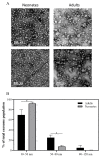Qualitative and Quantitative Comparison of Plasma Exosomes from Neonates and Adults
- PMID: 33672065
- PMCID: PMC7919666
- DOI: 10.3390/ijms22041926
Qualitative and Quantitative Comparison of Plasma Exosomes from Neonates and Adults
Abstract
Exosomes are extracellular vesicles that contain nucleic acids, lipids and metabolites, and play a critical role in health and disease as mediators of intercellular communication. The majority of extracellular vesicles in the blood are platelet-derived. Compared to adults, neonatal platelets are hyporeactive and show impaired granule release, associated with defects in Soluble N-ethylmaleimide-sensitive fusion Attachment protein REceptor (SNARE) proteins. Since these proteins participate in biogenesis of exosomes, we investigated the potential differences between newborn and adult plasma-derived exosomes. Plasma-derived exosomes were isolated by ultracentrifugation of umbilical cord blood from full-term neonates or peripheral blood from adults. Exosome characterization included size determination by transmission electron microscopy and quantitative proteomic analysis. Plasma-derived exosomes from neonates were significantly smaller and contained 65% less protein than those from adults. Remarkably, 131 proteins were found to be differentially expressed, 83 overexpressed and 48 underexpressed in neonatal (vs. adult) exosomes. Whereas the upregulated proteins in plasma exosomes from neonates are associated with platelet activation, coagulation and granule secretion, most of the underexpressed proteins are immunoglobulins. This is the first study showing that exosome size and content change with age. Our findings may contribute to elucidating the potential "developmental hemostatic mismatch risk" associated with transfusions containing plasma exosomes from adults.
Keywords: exosomes; neonatal platelets; platelet transfusion; protein S; proteomic; von Willebrand factor.
Conflict of interest statement
The authors declare no conflict of interest.
Figures





Similar articles
-
Increased neonatal platelet deposition on subendothelium under flow conditions: the role of plasma von Willebrand factor.Pediatr Res. 1999 Feb;45(2):270-5. doi: 10.1203/00006450-199902000-00019. Pediatr Res. 1999. PMID: 10022601
-
Increased shear stress- and ristocetin-induced binding of von Willebrand factor to platelets in cord compared with adult plasma.Thromb Haemost. 2004 Oct;92(4):682-7. doi: 10.1160/TH04-05-0270. Thromb Haemost. 2004. PMID: 15467896
-
Dissecting the biochemical architecture and morphological release pathways of the human platelet extracellular vesiculome.Cell Mol Life Sci. 2018 Oct;75(20):3781-3801. doi: 10.1007/s00018-018-2771-6. Epub 2018 Feb 9. Cell Mol Life Sci. 2018. PMID: 29427073 Free PMC article.
-
Neonatal platelets: mediators of primary hemostasis in the developing hemostatic system.Pediatr Res. 2014 Sep;76(3):230-7. doi: 10.1038/pr.2014.87. Epub 2014 Jun 18. Pediatr Res. 2014. PMID: 24941213 Free PMC article. Review.
-
Plasma neuronal exosomes serve as biomarkers of cognitive impairment in HIV infection and Alzheimer's disease.J Neurovirol. 2019 Oct;25(5):702-709. doi: 10.1007/s13365-018-0695-4. Epub 2019 Jan 4. J Neurovirol. 2019. PMID: 30610738 Free PMC article. Review.
Cited by
-
Comparative Brain Proteomic Analysis between Sham and Cerebral Ischemia Experimental Groups.Int J Mol Sci. 2024 Jul 9;25(14):7538. doi: 10.3390/ijms25147538. Int J Mol Sci. 2024. PMID: 39062782 Free PMC article.
-
Structural Similarities, in Relation with the Cross-Reactivity, of Hymenoptera Allergenic Dipeptidyl Peptidases IV-An Overall Comparison Including a New Dipeptidyl Peptidase IV Sequence from Vespa velutina.Toxins (Basel). 2023 Nov 14;15(11):656. doi: 10.3390/toxins15110656. Toxins (Basel). 2023. PMID: 37999519 Free PMC article.
-
Proteomic Analysis of Plasma Exosomes Enables the Identification of Lung Cancer in Patients With Chronic Obstructive Pulmonary Disease.Thorac Cancer. 2025 Jan;16(1):e15517. doi: 10.1111/1759-7714.15517. Thorac Cancer. 2025. PMID: 39778061 Free PMC article.
-
Preclinical validation of human recombinant glutamate-oxaloacetate transaminase for the treatment of acute ischemic stroke.iScience. 2024 Oct 9;27(11):111108. doi: 10.1016/j.isci.2024.111108. eCollection 2024 Nov 15. iScience. 2024. PMID: 39524351 Free PMC article.
-
[Proteomics of serum exosomes in children in the acute stage of Kawasaki disease: a prospective study].Zhongguo Dang Dai Er Ke Za Zhi. 2022 Apr 15;24(4):392-398. doi: 10.7499/j.issn.1008-8830.2110110. Zhongguo Dang Dai Er Ke Za Zhi. 2022. PMID: 35527414 Free PMC article. Chinese.
References
Publication types
MeSH terms
Substances
Grants and funding
LinkOut - more resources
Full Text Sources
Other Literature Sources
Miscellaneous

